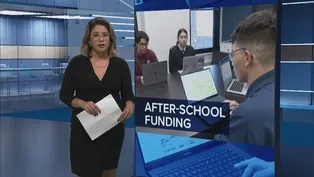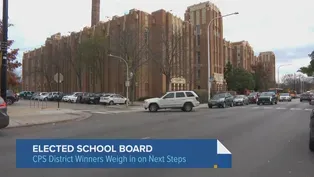
New Documentary Explores Life, Work of Leonardo da Vinci
Clip: 11/18/2024 | 7m 14sVideo has Closed Captions
Artist, scientist, engineer, philosopher — Leonardo da Vinci did a bit of everything.
Artist, scientist, engineer and philosopher — titles that only scratch the surface of what 15th century Italian Leonardo da Vinci achieved. A new two-part PBS documentary series from Ken Burns, Sarah Burns and David McMahon dissects da Vinci’s life in an effort to make sense of his work and the impact he has to this day.
Problems with Closed Captions? Closed Captioning Feedback
Problems with Closed Captions? Closed Captioning Feedback
Chicago Tonight is a local public television program presented by WTTW
WTTW video streaming support provided by members and sponsors.

New Documentary Explores Life, Work of Leonardo da Vinci
Clip: 11/18/2024 | 7m 14sVideo has Closed Captions
Artist, scientist, engineer and philosopher — titles that only scratch the surface of what 15th century Italian Leonardo da Vinci achieved. A new two-part PBS documentary series from Ken Burns, Sarah Burns and David McMahon dissects da Vinci’s life in an effort to make sense of his work and the impact he has to this day.
Problems with Closed Captions? Closed Captioning Feedback
How to Watch Chicago Tonight
Chicago Tonight is available to stream on pbs.org and the free PBS App, available on iPhone, Apple TV, Android TV, Android smartphones, Amazon Fire TV, Amazon Fire Tablet, Roku, Samsung Smart TV, and Vizio.

WTTW News Explains
In this Emmy Award-winning series, WTTW News tackles your questions — big and small — about life in the Chicago area. Our video animations guide you through local government, city history, public utilities and everything in between.Providing Support for PBS.org
Learn Moreabout PBS online sponsorshipavailable for the upcoming year friend.
Just back to you.
Artist scientist engineer and philosopher.
>> Titles which only scratched the surface of what, 15 th-century Italian Leonardo Da Vinci achieved a new two-part PBS documentary series from Ken Burns, Sarah Burns and David McMahon dissects the benches life in an effort to make sense of his work and the impact he has to this day.
Here's a look.
>> He filled his notebooks with calculations and Christians theories and innovations revealing the mind of him for the curious City.
In an age of astonishing artistic advances and a newfound reverence for humanity.
Leonardo da Vinci made his way.
He as of the ship, a little bit Santa.
>> A disciple of experience.
>> And joining us now with more is one of the film's directors and producers, David McMahon.
Welcome back.
Good to see you.
Thank you.
Grant So this is the first time Ken Burns film has focused on a non-American subject wide event.
She why now?
>> Well, Walter Isaacson, the biographer suggested the project to us.
He was working on a big bag fee of Leonardo Nissan.
This is a really compelling subject I think you should take it on and documentary and at first didn't seem obvious because we generally have not taken on many subjects from overseas.
But in this case, it felt really compelling for one Leonardo da Vinci was born a time when they're want to ban any archival footage film.
And so it would present a challenge to us.
How are we going to tell a story about this renaissance painter without this sort of material were accustomed to using.
We also quickly understood how little we knew about him.
And he became enormously compelling and felt like we had an opportunity to sort of deep in people's understanding of is a bit of enigma, a mystery.
Why is that?
>> Yeah, I think that, you know, he lived 500 years ago and at the end of his life, he didn't.
He wasn't a very public figure he didn't people can't really know him that well at that time.
So his legacy kind of builds over the centuries he was into so many different things.
Science art, geometry.
And so there's we're looking for any little tidbits that we tell us more about who he is.
And I think only find one.
people take some license and they run with it.
And so there's also this thing about him.
He feels a little bit like a wizard as kind of a Gandalf type feel about him.
He's got the big long beard and it feels like there's something magical about him.
And so our hope is to kind of ripped the beard off him and see the man actually was also have like, you know, sort of did that.
His drawings that look like gadgets at the time and the inventions that he sort of experimented with.
Yes.
And I think a lot of those drawings, a lot of those innovations were really only ever on the page.
And he didn't create a lot of them.
But a lot of those things.
There are many on president aspects to them, right.
And so for him to come up with a lot of those things, he had to have a profound imagination.
So which really interesting to me is where his deep curiosity about the world and everything news observing meets that imagination.
He's known for being ahead of his time.
Do do we think, you know, we have been taking his work for granted.
>> All this time.
I mean, do you think about like most famous work, right?
Lisa?
>> Yeah, I think that we can be distracted by Mona Lisa and the Last Supper and they're really profound n, you know, in an age of Instagram where you might go standing before that painting and take a picture last out and show you that it was there that you may missed opportunity to really understand Mona Lisa, but the painting actually means and so he is a man of his time and in that painting, I think it captures that at that time you would have if you're going take a learning out of pain, you would have also studied geometry.
You would have observed teacher.
You would have studied anatomy physiology.
And if you look closely at that painting, you can see all of that being poured into whether it's the smile and all the muscles that understands are activated in the smile or the backdrop.
And the really profoundly beautiful natural scenery behind there.
But he paints with understanding of all the size and for you all for the filmmakers.
How does this film look and feel different from your previous works out?
>> Well, we decided that we wanted to do for the audience is really get people between his ears.
And so we're using those notebooks to tell the story and to sort of guide our hand and what you find in the notebook says the Yulee blurs the lines between things like science and nature.
And so what we wanted to do was show to blur those lines ourselves.
So what we did was split the screen and show pictures that he would have drawn along with natural cinematography, our own of the natural world that he would have observed.
And then if it's an innovation, may be in a 3rd box.
We're showing some footage from the 20th century that captures something that feels a little bit like what it was.
He was designing on the page and we're hoping that that will help our audience see the way that he was observing the world in the way that he was thinking.
>> One of the unique things about she was that he was left-handed and he the way he wrote it was sort of a backwards, which is fascinating to me a little bit about that.
And what else that, you know, sort fascinating that you learned about this Yeah, he writes in a mere script, he was left-handed and I think really that was that paper is expensive because expensive and he's what he's writing.
He imagines publishing one day.
And so I think really he's trying and your script not to smudge.
The ink and that's really maybe what that was all about.
But it does take a profound mind, I think, to be able to do that reversal.
But I also think what it tells us is that we want to ascribe to that like something magical in fantastical.
And even to this day we have a deep interest in him because we think that everything he did is profound and has a certain magic.
And so you get lots of representations of Leonardo on the one.
A lot of them feel like his mysterious and chart of the mystery.
But I think what we're trying to do is get a little closer to the man, a man who is interested in science interest art interest playing everything.
He observed all that he was working on much of his work was also unfinished.
What was that about?
You know, that there are a lot of questions.
You know what a out of it.
Finish everything we have.
Many more I think that we we focus on the paintings and we are only maybe 15 or 17 of them that we know for sure have Leonardo's authorship or in part.
And so it feels like.
All of the art.
Everything was doing was an experiment.
And when he found out what he was going to find out, he moved on to something else.
So if you're trying to understand atmospheric perspective in the painting, he would go into the mountains, observe the mountains, make no, it's about the weather and then make his painting.
Maybe when he found out what it is he wanted to.
He moved on before you finish the painting and he seemed to be okay with that.
A few seconds left.
I know you just completed this, but what is next for you?
And the team?
>> Our next project and we already are underway with it is a kind of sequel to Ken Civil War film.
It's one that he's been wanting to make for 40 years.
>> And we're calling it emancipation to exodus.
And it's about the black experience between emancipation and the great migration.
So it's really about reconstruction, which we see is may be the most
Advocates Say After-School Programs Are at Risk of Losing Funding
Video has Closed Captions
Organizations are sounding the alarm, saying there's a state budget crisis. (4m 25s)
Meet 3 Members of Chicago's New Elected School Board
Video has Closed Captions
The Chicago Board of Education is in the midst of massive change. (8m 55s)
Providing Support for PBS.org
Learn Moreabout PBS online sponsorshipSupport for PBS provided by:
Chicago Tonight is a local public television program presented by WTTW
WTTW video streaming support provided by members and sponsors.













